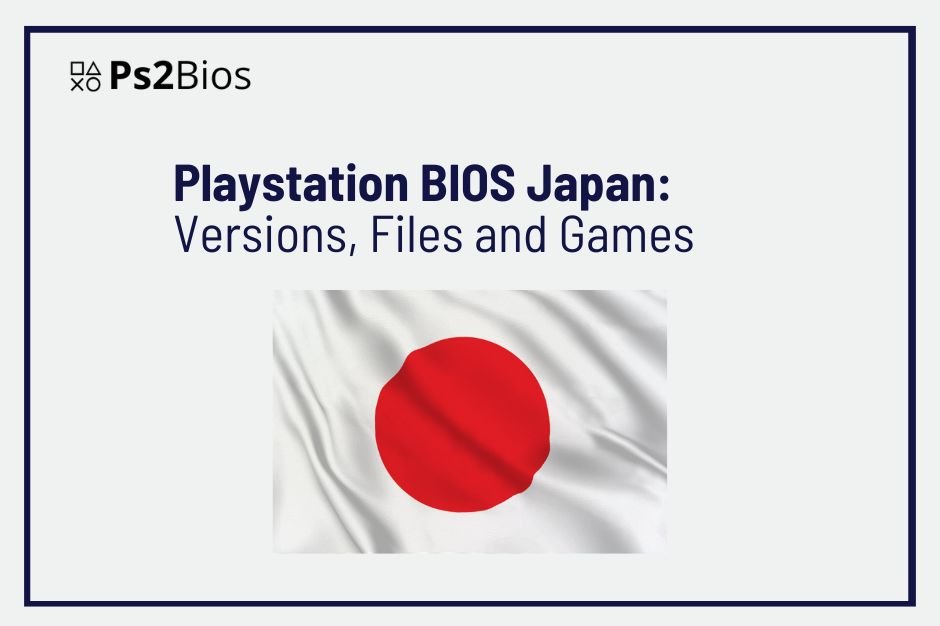PlayStation BIOS Japan refers to the specific set of Basic Input/Output System firmware files developed for Japanese variants of Sony’s original PlayStation (PS1) and PlayStation 2 (PS2) consoles. These BIOS files are essential firmware components that initiate and regulate the interaction between the console’s hardware and the game software, particularly when emulating systems via software like PCSX2 or ePSXe.
The Japanese BIOS differs from its North American and European counterparts in version identifiers, region-locking protocols, and compatibility with Japan-exclusive game libraries and hardware configurations. Understanding these regional nuances is critical for enthusiasts who want to emulate or preserve the authentic Japanese console experience.
- The PS1 Japan BIOS versions introduced key enhancements over time, including language encoding and disc boot optimizations.
- The PS2 BIOS Japan variants came with structural revisions tied closely to the SCPH series model updates.
- The BIOS file structure in Japan differs from other regions in naming conventions, encryption, and region-lock flags.
- Users looking to emulate must download the PS2 Japan BIOS for PCSX2 through legal backups, not piracy.
- Game compatibility with Japan BIOS includes exclusive titles like Initial D Special Stage and Shin Megami Tensei: If…
- Restrictions with Japan BIOS involve region-locked games and NTSC-J hardware emulation limits.
- The legality of using Japanese BIOS files varies based on your method of acquisition and local intellectual property laws.
What is PS Japan BIOS?
Sony Computer Entertainment Japan released the first PS BIOS under the SCPH-1000 model in December 1994, defining the baseline for firmware operation in Japan.
The PS BIOS functions as the embedded firmware stored in a ROM chip that enables low-level hardware initialization and game bootstrapping. In Japan, the BIOS also managed support for kanji characters, NTSC-J signal standard, and Japan-only hardware quirks such as serial port behavior on early models.
Unlike NTSC-U/C and PAL BIOS versions, the Japanese BIOS also features different system clock speeds and warning screen assets tailored to the local market. This regional BIOS is crucial for preserving accurate emulation of Japanese games, particularly those never localized outside Japan.
The next section explores how these foundations evolved across different BIOS versions for both the PS1 and PS2 in Japan.
What are the Different Versions of PS1 Japan BIOS?
BIOS versioning in Japan for the original PlayStation followed a consistent pattern based on the SCPH hardware line. Each BIOS version was tightly coupled with specific model numbers and manufacturing batches.
SCPH-1000 to SCPH-7000 Series (1994–1998)
- SCPH-1000 BIOS: Released with the launch unit in December 1994; contains early region code and memory card routines.
- SCPH-3000/3500 BIOS: Improved controller interface routines and added expanded peripheral support.
- SCPH-5000 BIOS: Fixed boot sector issues and refined error handling (1996).
- SCPH-7000 BIOS: The last major revision for PS1 in Japan before the shift toward PSOne; included broader optical lens calibration logic.
According to PSXDev.net (2021), the most stable PS1 Japan BIOS version for emulation is from the SCPH-7000 series, offering high compatibility and fewer crash issues in ePSXe and Mednafen.
With this chronological overview in mind, the next section dives into the PS2’s BIOS ecosystem, which was more complex and model-specific.
What are the Different Versions of PS2 Japan BIOS?
Sony’s PS2 BIOS Japan files were mapped directly to their SCPH-series model IDs, starting from SCPH-10000 to SCPH-90000, released between 2000 and 2008.
Major BIOS Variants and Features
- SCPH-10000 BIOS (2000): The original PS2 Japanese launch unit; had PCMCIA support for HDD but lacked a built-in DVD player.
- SCPH-30000 to SCPH-39000 (2001–2003): Introduced compatibility fixes, DVD playback, and early Memory Card BIOS patches.
- SCPH-50000 BIOS (2003): Known for major DVD boot stability and quieter fan speed protocols.
- SCPH-70000 to SCPH-90000 (2004–2008): Slim models with updated BIOS encryption, integrated IR sensor boot code, and better energy efficiency handling.
The PCSX2 Development Wiki (2023) recommends SCPH-39001 (Japan) as the most compatible BIOS file for emulation in PCSX2 1.6.0 and above.
The next section evaluates how Japanese BIOS files differ architecturally and functionally from other region files.
How the PS BIOS Japan Files are Different from Other Regions?
Japanese PS BIOS files diverge from other regional BIOS primarily in the NTSC-J encoding standard, text rendering routines, and anti-modchip security layers.
Key Differences
- NTSC-J Encoding: Outputs 480i video compatible with Japanese televisions, differing from PAL’s 576i.
- ROM Labeling: Japanese BIOS filenames (e.g.,
SCPH10000.BIN) differ from U.S. (SCPH39001.BIN) and EU variants. - Font Libraries: Includes native kanji and kana glyph support for in-game text rendering.
- Security Checks: Employ stricter boot sector verification for region-locked titles and peripherals.
As stated by PCSX2 Docs (2022), BIOS dumps must match the exact console region or emulators may fail to boot region-locked discs or display text incorrectly. Now let’s explore how to safely acquire and use these BIOS files in emulators.
Where to Download the PS2 BIOS Japan File for PCSX2?
PCSX2 Emulator Team clearly states that BIOS files must be dumped from your own console. Downloading from third-party websites may infringe on copyright laws.
Legal Method to Obtain:
- Use BIOS Dumper Tool: PCSX2 provides a BIOS dumper (linked on PCSX2.net).
- Hardware Needed: Japanese PS2 console, USB flash drive, and memory card adapter.
- Dump SCPH-xxxx BIOS: Transfer the
ROM1,ROM2,EROM, andNVMfiles. - Import into PCSX2: Navigate to
Config > BIOSand select the Japanese BIOS from the dumped folder.
Safety Tip:
Never trust .BIN downloads from unofficial forums. Instead, verify hashes against community-posted MD5 signatures on Redump.org or No-Intro BIOS databases.
With the BIOS installed, users gain access to a unique set of region-exclusive game titles.
What Games Can I Play Using the Japan PS2 BIOS?
Japan-exclusive PS2 games form a significant portion of the platform’s total library, with over 1,300 games released exclusively in Japan according to GameFAQs (retrieved 2023).
Notable Exclusives:
- Initial D: Special Stage – High-speed arcade drift racing, best played with native BIOS for accurate physics.
- Shin Megami Tensei: If… – A cult JRPG only released in Japan.
- Dark Cloud 2 (Japanese version) – Slightly different weapon systems and quest lines compared to global release.
- Tales of Destiny 2 – Not released in the West; requires Japanese BIOS for full boot.
According to PCSX2 Compatibility List (2024), over 90% of Japanese-only games run more stably on Japan BIOS than on international BIOS setups. However, there are still usage constraints tied to region-locked features.
What Are the Restrictions with the Japan PS2 BIOS?
Japan PS2 BIOS enforces several hardware and software limitations, especially for users outside Japan.
Restrictions Include:
- Region Locking: Games must match BIOS region. PAL or NTSC-U games won’t boot.
- Disc Authentication: Fails to load non-Japanese DVDs or backups without patching.
- Language Barrier: Menus and error screens are in Japanese, limiting accessibility.
- Peripheral Conflicts: Some accessories like the multitap or modem may not initialize properly with region-mismatched emulation.
These constraints are hardcoded and cannot be bypassed through emulator configuration alone without violating license agreements. This leads to the final point—legality.
Is It Legal to Download and Use the Japanese BIOS?
Sony Interactive Entertainment considers BIOS dumps to be protected software. However, the legality depends on the method of acquisition and jurisdiction.
Legal Guidelines:
- Personal Backups: Legal in most countries (U.S., Japan, EU) under Fair Use if you own the original console.
- Distribution: Uploading or downloading BIOS from forums or ROM sites is illegal and violates the DMCA (U.S.) and Japan’s Unfair Competition Prevention Act.
- Emulator Use: PCSX2 and others are legal, but require you to import your own BIOS.
In 2020, Ars Technica reported a crackdown on illegal BIOS hosts after complaints from Sony under DMCA provisions. Emulation remains legal if you comply with local software copyright law.


